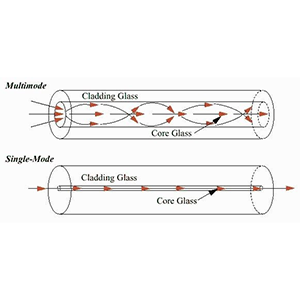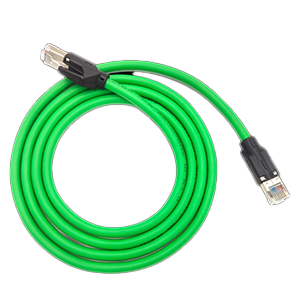Optical modules play a key role in network equipment. This article will compare the two main types of optical modules, Cisco SFP and GBIC. We will first define the basic functions of optical modules and outline Cisco’s leadership in the field of optical modules. Next, we will introduce the characteristics of GBIC and SFP optical modules respectively.
GBIC modules use a larger shell size and support rates of 1Gbps and below, mainly used in old network equipment; while SFP modules use a smaller shell size and support rates of 1Gbps and 10Gbps, with the advantages of smaller size and higher performance. Finally, we will compare the differences between the two optical modules in terms of size, interface type, supported rate, power consumption and heat dissipation requirements.
What is an optical module
An optical module is a device used for optical fiber communication, which is responsible for converting electrical signals into optical signals and transmitting them through optical fibers. It is usually composed of an optical transmitter, an optical receiver, and a control circuit. It is widely used in data centers, network equipment, and telecommunications systems to support high-speed, long-distance data transmission.
Basic functions of optical modules:
An optical module is a photoelectric conversion device, and its basic functions include:
(1) Convert optical signals transmitted by optical fibers into electrical signals:
- The optical module can convert optical signals received from optical fibers into data signals in electrical form.
(2) Realize optical interface connection between network devices:
- The optical module provides an optical interface for connecting network devices such as switches and routers.
- The optical signal transmission between devices is realized through the optical interface.
In general, the optical module is a key component for realizing photoelectric conversion and device connection in the optical fiber network.
Cisco’s position in the field of optical modules:
As a leading company in the field of network equipment, Cisco also plays a leading role in optical module products:
(1) Cisco provides a variety of optical module models:
- Including optical modules with different interface specifications such as SFP, SFP+, QSFP.
- To meet the needs of different network equipment and application scenarios.
(2) Cisco optical modules enjoy a good reputation in the industry:
- Cisco optical module products are highly trusted for their excellent quality and performance.
- As an industry standard, they are widely used in Cisco and other network equipment.
In short, Cisco has become one of the industry leaders in optical module products with its leading position in the field of network equipment, providing users with a wealth of choices.
Features of GBIC optical module
GBIC (Gigabit Interface Converter) optical module is a pluggable fiber interface module that supports gigabit data transmission. Its features include modular design, easy replacement and upgrade, and support for multiple wavelengths and transmission distances. GBIC is widely used in network equipment, providing flexible fiber connection solutions.
Basic structure of GBIC module:
GBIC (Gigabit Interface Converter) is an earlier optical module standard, and its main features are as follows:
(1) Larger shell size:
- The shell size of GBIC module is large, about 2.5 inches long.
(2) Support 1Gbps and below:
- GBIC module mainly supports 1Gbps and lower transmission rates.
These physical characteristics of GBIC modules match the network environment and technology level at the time of its birth.
Main application scenarios of GBIC modules:
GBIC modules once played an important role in network construction:
(1) Widely used in old network equipment:
- GBIC modules are widely used in earlier network equipment such as routers and switches.
(2) Gradually replaced by new models:
- With the development of network technology, GBIC modules are gradually replaced by new models with smaller size and stronger performance.
- Module standards such as SFP and SFP+ are widely used in current networks.
In general, GBIC modules represent the optical interface standard in earlier network equipment. With the advancement of technology, they are gradually being replaced by more advanced optical modules. However, GBIC modules may still be used in some old network equipment.
Features of SFP optical modules
SFP (Small Form-factor Pluggable) optical modules are compact pluggable optical modules that support multiple data transmission rates and wavelengths. Its features include small size, low power consumption, and easy replacement and upgrade. SFP is widely used in network equipment, providing flexible and efficient fiber connection solutions.
Basic features of SFP modules:
SFP (Small Form-factor Pluggable) optical modules are a newer optical module standard, which has the following main features:
(1) Smaller shell size:
- The shell size of the SFP module is smaller than that of GBIC, about 1 inch long.
(2) Support 1Gbps and 10Gbps rates:
- SFP modules can support two mainstream network transmission rates of 1Gbps and 10Gbps.
Compared with GBIC, the SFP module’s miniaturized design and higher transmission rate make it more suitable for the needs of current network equipment.
Main advantages of SFP modules:
Compared with GBIC, SFP modules have the following advantages:
(1) Small size and flexible installation:
- The small size makes SFP modules easier to install on network equipment.
- It helps to improve the port density and space utilization of the equipment.
(2) Higher transmission bandwidth and performance:
- SFP modules support 10Gbps high-speed transmission, meeting the needs of high-bandwidth applications.
- Compared with GBIC, SFP modules can provide stronger performance and transmission capabilities.
In short, SFP modules have become the widely used optical module standard in current network equipment due to their smaller size and higher performance indicators, replacing the early GBIC modules.
Comparison of the differences between Cisco SFP and GBIC
The main differences between Cisco SFP (Small Form-factor Pluggable) and GBIC (Gigabit Interface Converter) are size and performance. SFP modules are smaller, support higher data rates and a wider range of wavelength options, and have lower power consumption. GBIC is larger and is mainly used for older equipment and lower-speed applications. SFP has become the mainstream choice because of its greater flexibility and efficiency.
1. Size and interface type:
- GBIC modules use a larger shell size, about 2.5 inches long.
- SFP modules use a smaller size, about 1 inch long.
- This makes SFP modules easier to install on compact network devices.
2. Supported transmission rates:
- GBIC modules mainly support transmission rates of 1Gbps and lower.
- SFP modules support two mainstream network transmission rates of 1Gbps and 10Gbps.
- This makes SFP modules suitable for application scenarios with higher bandwidth.
3. Power consumption and heat dissipation requirements:
- GBIC modules usually have high power consumption and require an external heat dissipation mechanism.
- In contrast, SFP modules have lower power consumption and can be built into network devices for heat dissipation.
- This reduces the requirements for SFP modules in terms of device integration.
In general, SFP modules provide smaller size, higher transmission bandwidth and lower power consumption requirements than GBIC modules, making them more suitable for the application requirements of current high-speed network devices. This is also the main reason why SFP gradually replaces GBIC as the mainstream optical module standard.
Summary
Cisco SFP and GBIC optical modules each have their own applicable scenarios and play an important role in building high-performance network solutions. Our company has long been focusing on the research and development and application of optical module technology and has rich practical experience. We provide a full range of Cisco optical module products, including SFP and GBIC types, which can meet the needs of different network environments.
Our optical module products adopt industry-leading technical solutions and have achieved excellent levels in transmission performance, reliability and compatibility. At the same time, our engineering team will provide you with professional demand analysis and solution design services to ensure that the deployed optical module solutions can meet your actual needs to the greatest extent. Contact us now to learn more.
Cisco SFP and GBIC FAQ
A Cisco SFP (Small Form-Factor Pluggable) module is a compact, hot-swappable transceiver used for connecting networking devices like switches and routers. It supports various types of connections, including Ethernet, fiber, and more.
A Cisco GBIC (Gigabit Interface Converter) module is an older type of transceiver used to connect networking equipment. It supports gigabit-speed connections over different types of media, including fiber and copper.
SFP modules are smaller and more compact compared to GBIC modules. This allows SFP modules to be used in higher-density applications, where more ports are needed in a smaller space.
Generally, SFP modules cannot be directly used in place of GBIC modules because the interfaces and slot designs are different. However, many modern networking devices have replaced GBIC slots with SFP slots, making SFP the more current standard.
SFP modules offer a smaller form factor, higher port density, and often greater flexibility in terms of supported connection types and speeds. They also support hot-swapping, allowing modules to be replaced or upgraded without powering down the device.
SFP modules can support a variety of connections including Ethernet (10/100/1000 Mbps), fiber (single-mode and multi-mode), and other types like Fiber Channel and SONET, depending on the specific module.
GBIC modules also support various types of connections, including Gigabit Ethernet and fiber channels, but they are limited to gigabit speeds and do not support newer, higher-speed connections as SFP modules do.
Yes, compatibility issues can arise due to different slot designs and standards. Devices designed for GBIC modules will not typically accept SFP modules, and vice versa. Always check the specifications of your networking equipment.
Using SFP modules can improve network performance by providing higher port density, better flexibility, and support for newer standards and higher speeds compared to GBIC modules.
Yes, newer alternatives include SFP+ (for speeds up to 10 Gbps), QSFP (Quad SFP, for speeds up to 40 Gbps or 100 Gbps), and other high-speed transceivers designed to meet the demands of modern high-speed networking.



